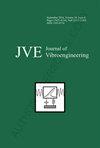动力回流液压传动系统的非线性动力学分析
IF 0.9
Q4 ENGINEERING, MECHANICAL
引用次数: 0
摘要
动力回流液压传动系统(PRHTS)是最近引入的一种无级变速传动系统,能够提高工程车辆的燃油经济性。为了研究PRHTS的非线性动力学特性,将行星齿轮系和变矩器的动力学模型相结合,建立了其非线性动力学模型。行星齿轮系的动力学模型揭示了啮合阻尼、时变啮合刚度和传动误差的参数。采用四阶龙格-库塔方法求解了PRHTS的非线性动力学方程。通过分岔图观察系统的动态轨道,分岔图使用无量纲的内部激励频率和啮合阻尼比作为控制参数。数值算例表明了单周期运动、多周期运动、准周期运动和混沌运动的动力学演化机制。从PRHTS的分岔图、动力学轨迹、相平面图和庞加莱图中识别出混沌运动的开始。仿真结果提供了对PRHTS中发生不期望的动态运动的操作条件的理解,并为PRHTS的有效动态设计提供了宝贵的信息。本文章由计算机程序翻译,如有差异,请以英文原文为准。
Nonlinear dynamic analysis of power reflux hydraulic transmission system
Power reflux hydraulic transmission system (PRHTS), which is a recently introduced continuously variable transmission system, enables the improvement of fuel economy of construction vehicles. For investigating the nonlinear dynamic characteristics of PRHTS, its nonlinear dynamic model is established by merging the dynamic models of a planetary gear train and torque converter. A dynamical model of the planetary gear train reveals the parameters of mesh damping, time-varying mesh stiffness, and transmission error. The nonlinear dynamic equations of the PRHTS are solved using the fourth-order Runge-Kutta method. The dynamic orbits of the system are observed through bifurcation diagrams, which use the internal excitation frequency and meshing damping ratios, both of which are dimensionless, as control parameters. Numerical examples show the dynamic evolution mechanism involving one-period motion, multi-periodic motion, quasi-periodic motion, and chaotic motion. The onset of chaotic motion is identified from bifurcation diagrams, dynamic trajectories, phase plane diagram, and Poincaré maps of the PRHTS. The simulation results provide an understanding of the operating conditions under which undesirable dynamic motion occurs in PRHTS and serve as invaluable information for effective dynamic design of PRHTS.
求助全文
通过发布文献求助,成功后即可免费获取论文全文。
去求助
来源期刊

Journal of Vibroengineering
工程技术-工程:机械
CiteScore
1.70
自引率
0.00%
发文量
97
审稿时长
4.5 months
期刊介绍:
Journal of VIBROENGINEERING (JVE) ISSN 1392-8716 is a prestigious peer reviewed International Journal specializing in theoretical and practical aspects of Vibration Engineering. It is indexed in ESCI and other major databases. Published every 1.5 months (8 times yearly), the journal attracts attention from the International Engineering Community.
 求助内容:
求助内容: 应助结果提醒方式:
应助结果提醒方式:


